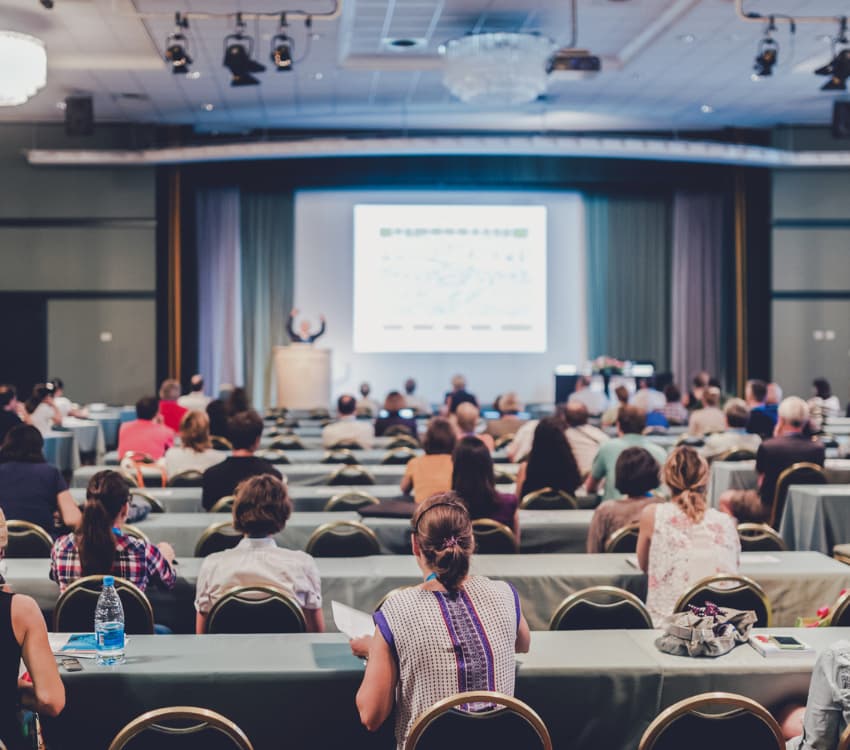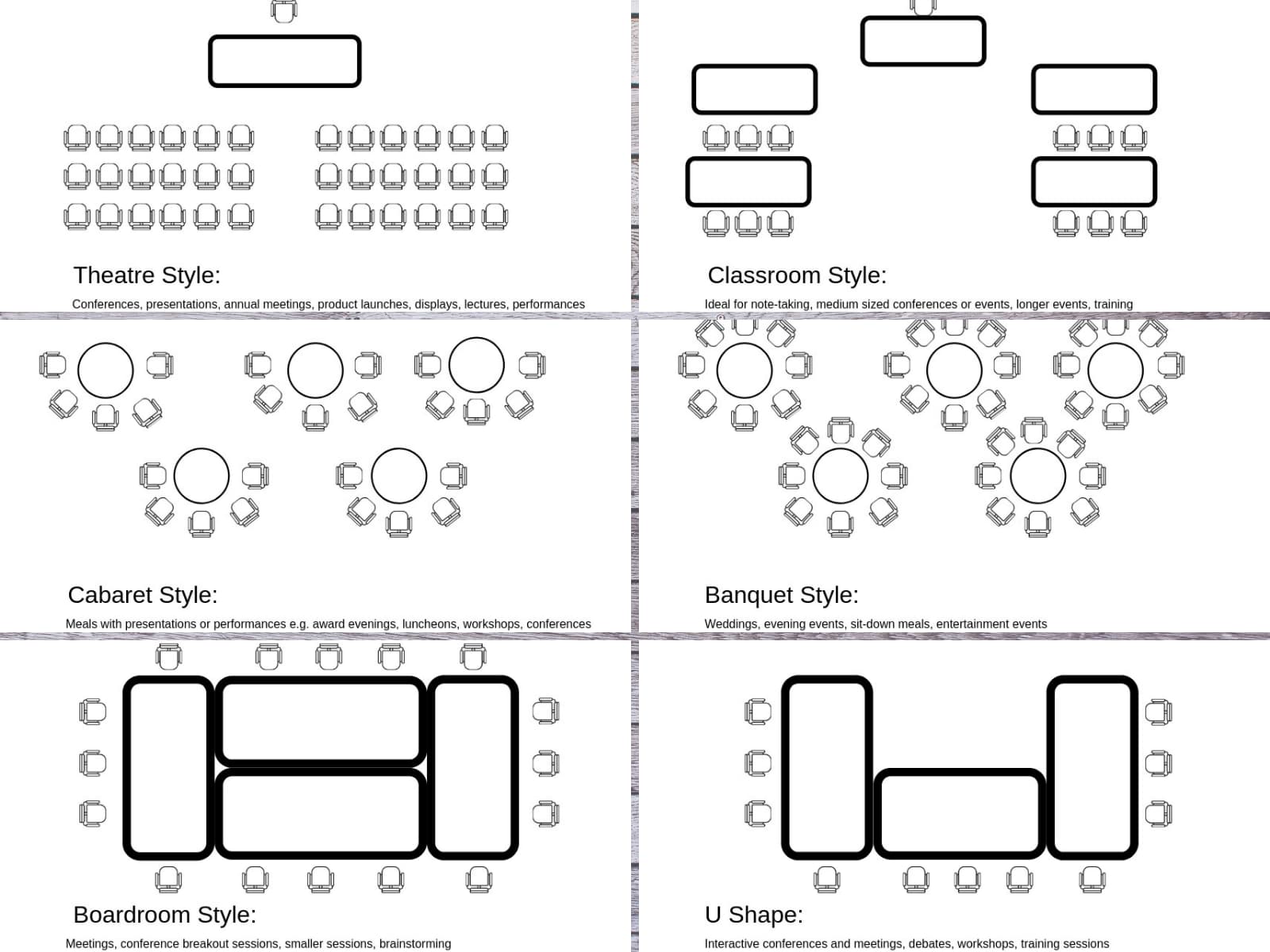Planning an event involves more than just booking a venue; it’s about designing a space that enhances the guest experience. A well-thought-out layout ensures smooth movement, clear sightlines, and a welcoming atmosphere, while the right event design creates a memorable setting that aligns with the occasion.
Whether it’s a corporate seminar, wedding reception, gala dinner, or networking event, choosing the correct table and chair arrangements, lighting, and décor can elevate the event. Here’s a guide to help you plan the perfect layout and design.

Event Layouts
The event layout is the physical arrangement of a venue’s tables, chairs, and key elements. It determines how guests move through the space, interact with each other, and engage with the event.
The layout depends on:
- Event purpose – A formal dinner requires a different setup than a networking event.
- Guest count – Ensuring enough seating without overcrowding.
- Room dimensions – Maximising space while maintaining accessibility and comfort.
- Focal points – Positioning stages, dance floors, and presentation areas effectively.
- Accessibility – Providing clear pathways and accommodating wheelchair users.
Popular Event Layouts for Tables and Chairs
Banquet Style (Round Tables)
Perfect for weddings, gala dinners, and formal gatherings, this layout features round tables seating 6 to 10 guests. It encourages conversation and an elegant setting but requires more space per guest.
Theatre Style (Rows of Chairs)
Ideal for conferences, presentations, and lectures, the seating is arranged in rows facing a stage. This setup maximises capacity but doesn’t allow for much interaction.
Classroom Style (Tables with Forward-Facing Chairs)
This layout, common in training sessions and workshops, features long tables with chairs facing the front. It allows guests to take notes and interact with speakers.
Cabaret Style (Half-Round Seating)
This layout, often used for business presentations, networking events, and award ceremonies, consists of round tables with seating only on one side facing the stage. It provides good visibility for all attendees.
Boardroom Style
A single large table surrounded by chairs, suitable for executive meetings and strategy sessions. This setup fosters discussion and collaboration.
U-Shaped Layout
Designed for interactive discussions, panel meetings, and training sessions, the room has tables arranged in a U-shape with chairs on the outside. This layout ensures engagement with a central speaker.

Cocktail/Standing Layout
This setup is best for networking events, product launches, and social receptions. It involves high-top tables or no seating, encouraging guests to move freely and interact.
Lounge Style
A mix of sofas, armchairs, and coffee tables creates a relaxed atmosphere for VIP events or casual networking sessions.
Event Design
The Right Venue
The venue sets the stage for seating, lighting, and décor choices. Consider:
- Natural lighting and how it affects the mood.
- Room dimensions to ensure the layout fits comfortably.
- Existing furniture and whether additional seating is needed.
Lighting
Lighting has a significant impact on the guest experience.
- Dim lighting works well for networking and evening receptions.
- Bright lighting is ideal for speeches and presentations.
- Spotlights and uplighting can highlight areas like the stage or entrance.
Colour and Branding
Colour plays a role in setting the tone.
- Gold and deep tones create a luxurious feel.
- Soft pastels are perfect for weddings and social events.
- Cool blues and greens work well for corporate and educational events.
- Incorporate brand colours through decor, lighting, and printed materials.
Furniture Choices
- The right furniture enhances comfort and functionality.
- Banquet chairs work well for formal events, while bar stools and sofas create a more relaxed setting.
- Table settings, centrepieces, and decorative elements add personality and style.
Considerations for Event Planning
Guest Flow & Accessibility
- Ensure wide walkways between tables for ease of movement.
- Position areas like the buffet, bar, and stage strategically.
- Create a clear path for wheelchair users and emergency access.
Health & Safety Compliance
- Ensure all emergency exits remain accessible.
- Stick to venue capacity limits to avoid overcrowding.
- Plan for fire safety measures and evacuation routes.
Storage & Layout Flexibility
- Some events require rearranging furniture mid-event.
- Ensure storage areas for excess chairs and tables.
- Consider the staffing and time needed to reset the room.
Bringing Your Event Vision to Life
The right event layout and design make all the difference in creating an unforgettable experience. Whether it’s a meeting, conference, or wedding reception, thoughtful planning ensures guests are comfortable, engaged, and enjoy the event to its fullest.
We offer a wide range of event furniture at BE Furniture Sales, from banqueting chairs and trestle tables to lounge seating. Whether you’re hosting a formal gathering or a relaxed networking event, we have the perfect furniture options, including event furniture hire to bring your vision to life.
Related Articles
- Event Seating Layouts
- Using Stacking Chairs to Save Space in Your Venue
- The Right Outdoor Furniture for Your Business
- Christmas Furniture – Hotels, Venues & Restaurants
- Guide to Crowd Control Barriers for Events, Exhibitions, Festivals